Solar Astrometry in Rome at the End of the Maunder Minimum
Abstract
1. Structure of the Article
2. The Clementine Gnomon and Its Historical Background
Historical Context: Churches as Observatories
3. Secular Variations in the Solar Parameters in the Maunder Minimum
4. Modern Solar Observations at the Clementine Gnomon
- The meridian measures of the solar diameter have been accompanied by meteorological data (pressure, temperature, and humidity) and sky aspects (cloudy, with veils or clear) to understand their contributions to the observed diameter’s length.
- All the meridian transits have been recorded and they are available on YouTube. (https://www.youtube.com/channel/UCe18v3EZ8w2qmd8jW6mYV5w/videos accessed on 4 June 2025 search “Transito meridiano a S. Maria degli Angeli” + the date in Italian, e.g., “3 maggio 2025”).
- The daily meridian positions of the solar limbs on the brass line are compared with the ephemerides to disentangle systematics from the astronomical seeing, meteorological, and personal equations.
- a.
- The signal to noise ratio reduced by meteorological conditions and ambient light;
- b.
- Solar limb darkening;
- c.
- The penumbra (diameter of the horizontal pinhole, fixed);
- d.
- The cylinder effect (pinhole vertical thickness, which changes the effective pinhole area);
- e.
- The light reflected inside the marble, which enlarges the image southwards in summer time;
- f.
- The airmass extinction combined with the effective pinhole area.
4.1. The Pinhole of the Clementine Gnomon
4.2. The Meridian Line and Its Marbles
4.3. Extra-Meridian Measurements on Vanvitelli’s Marbles
4.4. The Turbulence at the Clementine Gnomon
4.5. Images with Tiny Clouds
5. Solar Diameters in 1701 and 1702
6. Comparison Between Bianchini (1702) and Present Data (2018–2025)
7. Simulating Solar Diameter Variations and the Observations Made in 1655–1736
- Summer. The Gaussian noise is −18″ ± 48″ (from extra-meridian data, since the summer solstice in St. Maria degli Angeli occurs on the figure of Cancer).
8. Conclusions and Perspectives
Author Contributions
Funding
Data Availability Statement
Acknowledgments
Conflicts of Interest
References
- Heilbron, J.L. The Sun in the Church; Harvard Universtiy Press: Cambridge, MA, USA, 2001. [Google Scholar]
- Heilbron, J.L. The Incomparable Monsignor: Francesco Bianchini’s World of Science, History, and Court Intrigue; Oxford University Press: Oxford, UK, 2022. [Google Scholar]
- Bianchini, F. De Nummo et Gnomone Clementino, Romae. 1703. Available online: https://archive.org/details/dekalendarioetcy00bian/ (accessed on 4 June 2025).
- Bianchini, F. Correspondance; Fondo Bianchini; Biblioteca Vallicelliana: Roma, Italy, 1702. [Google Scholar]
- Sigismondi, C. Lo Gnomone Clementino, Roma (2009). Gerbertus 2014, 7, 3–80. [Google Scholar]
- Sigismondi, C. Earth’s Obliquity and Stellar Aberration Detected at the Clementine Gnomon (Rome, 1703). Phys. Sci. Forum 2021, 2, 49. [Google Scholar] [CrossRef]
- Danti, E. Usus et Tractatio Gnomoni Magni, Bononiae: Apud Ioannem Rossium. 1576. Available online: https://opac.museogalileo.it/imss/resourceXsl?uri=365759 (accessed on 6 June 2025).
- Cassini, G.D. La Meridiana del Tempio di S. Petronio: Tirata, e Preparata per le Osseruazioni Astronomiche L’anno 1655: Riuista, e Restaurata L’anno 1695, in Bologna: Per L’erede di Vittorio Benacci (1695). Available online: https://archive.org/details/lameridianadelte00cass (accessed on 4 June 2025).
- Manfredi, E. Opera Omnia, 3: De Gnomone Meridiano Bononiensi; Lelio dalla Volpe: Bologna, Italy, 1736. [Google Scholar]
- Tovar, I.; Aparicio, A.J.P.; Carrasco, V.M.S.; Gallego, M.C.; Vaquero, J.M. Analysis of Solar Diameter Measurements Made at the Basilica of San Petronio During and After the Maunder Minimum. Astrophys. J. 2021, 912, 122. [Google Scholar] [CrossRef]
- da Passano, C.F.; Monti, C.; Mussio, L. La Meridiana Solare del Duomo di Milano, Verifica e Ripristino Nell’anno 1976; Veneranda Fabbrica del Duomo di Milano: Milan, Italy, 1977. [Google Scholar]
- Galilei, G. Istoria e Dimostrazioni Intorno alle Macchie Solari; Accademia dei Lincei: Roma, Italy, 1613. [Google Scholar]
- Available online: https://articles.adsabs.harvard.edu/pdf/1844AN.....21..233S (accessed on 4 June 2025).
- Maunder, E.W. A prolonged sunspot minimum. In Knowledge: An Illustrated Magazine of Science; #247—Knowledge; A Monthly Record of Science v.17 1894—Full View; HathiTrust Digital Library: Champaign, IL, USA, 1894; Volume 17, pp. 173–176. Available online: https://babel.hathitrust.org/cgi/pt?id=uc1.c2834645&view=1up&seq=247 (accessed on 4 June 2025).
- Maunder, E.W. The prolonged sunspot minimum, (1645–1715). J. Br. Astron. Assoc. 1922, 32, 140–145. [Google Scholar]
- Usoskin, I.G. A history of solar activity over millennia. Living Rev. Sol. Phys. 2023, 20, 2. [Google Scholar] [CrossRef]
- Whitehouse, D. Il Sole Una Biografia; Mondadori: Milano, Italy, 2007. [Google Scholar]
- Carrasco, V.M.S.; Vaquero, J.M. Sunspot Observations During the Maunder Minimum from the Correspondence of John Flamsteed. Sol. Phys. 2016, 291, 2493–2503. [Google Scholar] [CrossRef]
- Carrasco, V.M.S.; Vaquero, J.M.; Gallego, M.C.; Muñoz-Jaramillo, A.; de Toma, G.; Galaviz, P.; Arlt, R.; Pavai, V.S.; Sánchez-Bajo, F.; Álvarez, J.V.; et al. Sunspot Characteristics at the Onset of the Maunder Minimum Based on the Observations of Hevelius Astrophys. Astrophys. J. 2019, 886, 18. [Google Scholar] [CrossRef]
- Carrasco, V.M.S.; García-Romero, J.M.; Vaquero, J.M.; Rodríguez, P.G.; Foukal, P.; Gallego, M.C.; Lefèvre, L. The Umbra–Penumbra Area Ratio of Sunspots During the Maunder Minimum. Astrophys. J. 2018, 865, 88. [Google Scholar] [CrossRef]
- Carrasco, V.M.S.; Gallego, M.C.; Arlt, R.; Vaquero, J.M. On the Use of Naked-Eye Sunspot Observations During the Maunder Minimum. Astrophys. J. 2020, 904, 60. [Google Scholar] [CrossRef]
- Shapley, H. (Ed.) Climatic Change. Evidence, Causes, and Effects; Harvard University Press: Cambridge, MA, USA, 1953. [Google Scholar]
- CNES Toulouse. Sun and Climate. 1980. Available online: https://catalogue.bnf.fr/ark:/12148/cb34658419f (accessed on 4 June 2025).
- Penza, V.; Berrilli, F.; Bertello, L.; Cantoresi, M.; Criscuoli, S.; Giobbi, P. Total Solar Irradiance During the Last Five Centuries. Astrophys. J. 2022, 987, 84. [Google Scholar] [CrossRef]
- Sullivan, W.; Thorp, M.; Tovar, G.; Look, J. Modern Observations Using the 1702 Meridian Line of the Basilica of Santa Maria Degli Angeli e dei Martiri (Rome). 2016. Available online: https://archive.sundialsoc.org.uk/wp-content/uploads/Bulletin-29iii-Sullivan.pdf (accessed on 4 June 2025).
- Sigismondi, C. Pinhole giant meridian lines: A review on ancient data retrieval and modern observations (IGEA-ZIA campaign). Gerbertus 2022, 16, 29. [Google Scholar]
- Sigismondi, C. Measuring the angular solar diameter using two pinholes. Am. J. Phys. 2002, 70, 1157. [Google Scholar] [CrossRef]
- Espenak, F. Earth at Perihelion and Aphelion: 1701 to 1800. Available online: https://astropixels.com/ephemeris/perap/perap1701.html (accessed on 13 February 2025).
- Catamo, M.; Lucarini, C. Il Cielo in Basilica; Arpa-Agami: Roma, Italy, 2012. [Google Scholar]
- Schiavo, A. La Meridiana di S. Maria Degli Angeli; Istituto Poligrafico e Zecca Dello Stato: Roma, Italy; Libreria dello Stato: Roma, Italy, 1993. [Google Scholar]
- Lamy, P.; Prado, J.-Y.; Floyd, O.; Rocher, P.; Faury, G.; Koutchmy, S. A Novel Technique for Measuring the Solar Radius from Eclipse Light Curves—Results for 2010, 2012, 2013, and 2015. Sol. Phys. 2015, 290, 2617–2648. [Google Scholar] [CrossRef]
- Quaglia, L.; Irwin, J.; Emmanouilidis, K.; Pessi, A. Estimation of the Eclipse Solar Radius by Flash Spectrum Video Analysis. Astrophys. J. 2021, S256, 36. [Google Scholar] [CrossRef]
- Clavius, C. Commentarius in Sphaeram; Ex Officina Dominici Basae Romae: Rome, Italy, 1581. [Google Scholar]
- Halley, E. Philosophical Transactions (1683–1775); Royal Society: London, UK, 1717; Volume 29, pp. 245–262. [Google Scholar]
- Eddy, J.; Boornazian, A.A.; Clavius, C. Shrinking Sun. Sky Telesc. 1980, 60, 10. [Google Scholar]
- Dunham, D.W.; Sofia, S.; Fiala, A. Observations of a probable change in the solar radius between 1715 and 1979. Science 1980, 210, 1234. [Google Scholar] [CrossRef] [PubMed]
- Rosa, P. Intorno ad una identità di periodi di fenomeni fotosferici e magnetici in connessione con il moto proprio del Sole. Mem. Degli Spettrosc. Italiani 1874, 3, 67. [Google Scholar]
- Egidi, A.; Caccin, B.; Sofia, S.; Heaps, W.; Hoegy, W.; Twigg, L. High-Precision Measurements of the Solar Diameter and Oblateness by the Solar Disk Sextant (SDS) Experiment. Sol. Phys. 2006, 235, 407–418. [Google Scholar] [CrossRef]
- Corbard, T.; Ikhlef, R.; Morand, F.; Meftah, M.; Renaud, C. On the importance of astronomical refraction for modern solar astrometric measurements. Mon. Not. R. Astron. Soc. 2019, 483, 3865–3877. [Google Scholar] [CrossRef]
- Schneider, G.; Pasachoff, J.M.; Golub, L. The black drop effect. Sky Telesc. 2012, 123, 8. [Google Scholar]
- Meftah, M.; Corbard, T.; Irbah, A.; Ikhlef, R.; Morand, F.; Renaud, C.; Hauchecorne, A.; Assus, P.; Borgnino, J.; Chauvineau, B.; et al. Ground-based measurements of the solar diameter during the rising phase of solar cycle 24. Astron. Astrophys. 2014, 569, A60. [Google Scholar] [CrossRef]
- Auwers, A. Der Sonnendurchmesser und der Venusdurchmesser nach den Beobachtungen an den Heliometern der deutschen Venus-Expeditionen. Astron. Nachrichten 1891, 128, 361. [Google Scholar] [CrossRef]
- IAU Inter-Division A-G Working Group on Nominal Units for Stellar & Planetary Astronomy. Resolution B3 on Recommended Nominal Conversion Constants for Selected Solar and Planetary Properties. 2015. Available online: https://arxiv.org/pdf/1510.07674 (accessed on 4 June 2025).
- Haberreiter, M.; Schmutz, W.; Kosovichev, A.G. Solving the Discrepancy Between the Seismic and Photospheric Solar Radius. Astrophys. J. Lett. 2008, 675, L53. [Google Scholar] [CrossRef]

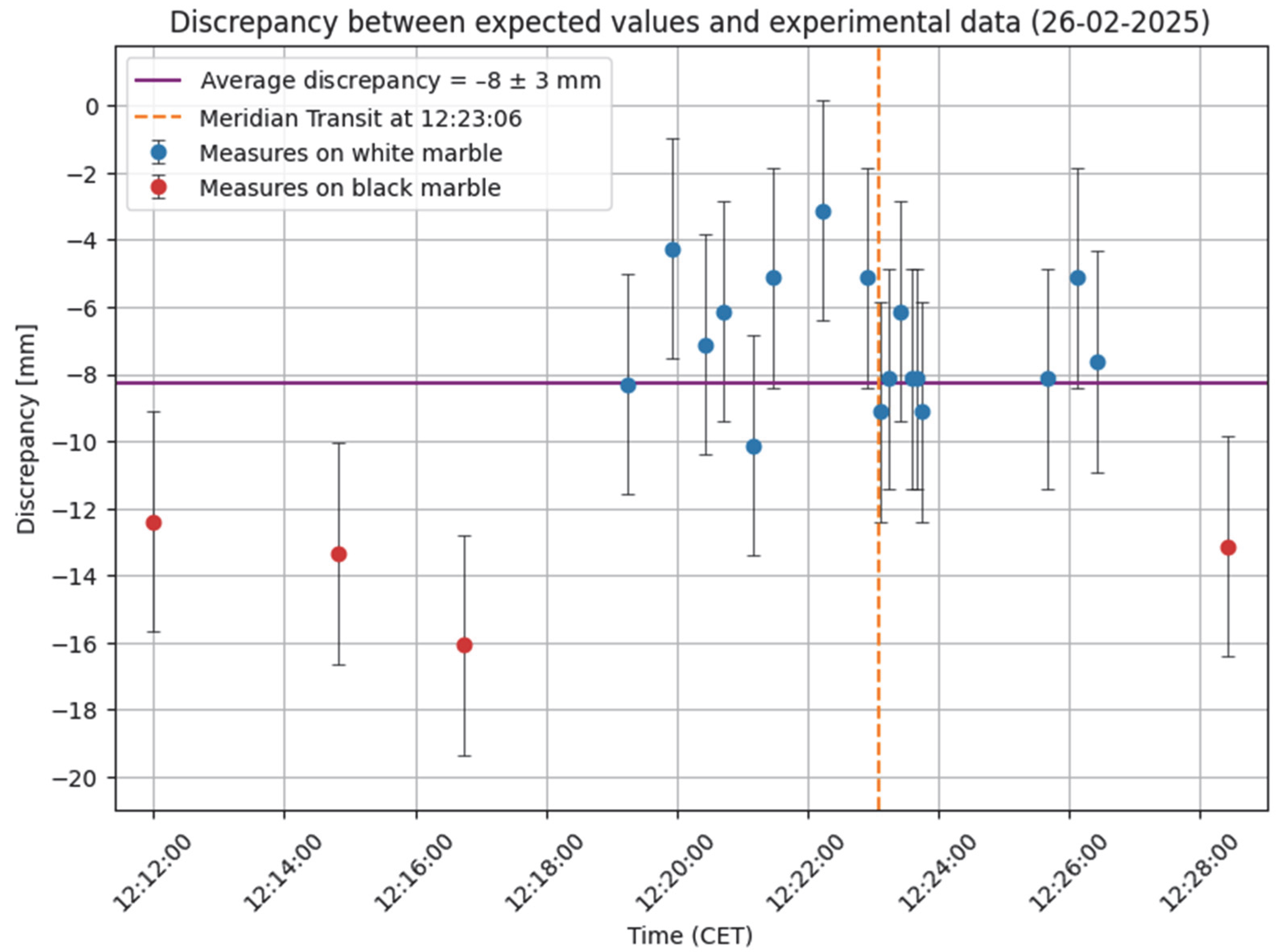
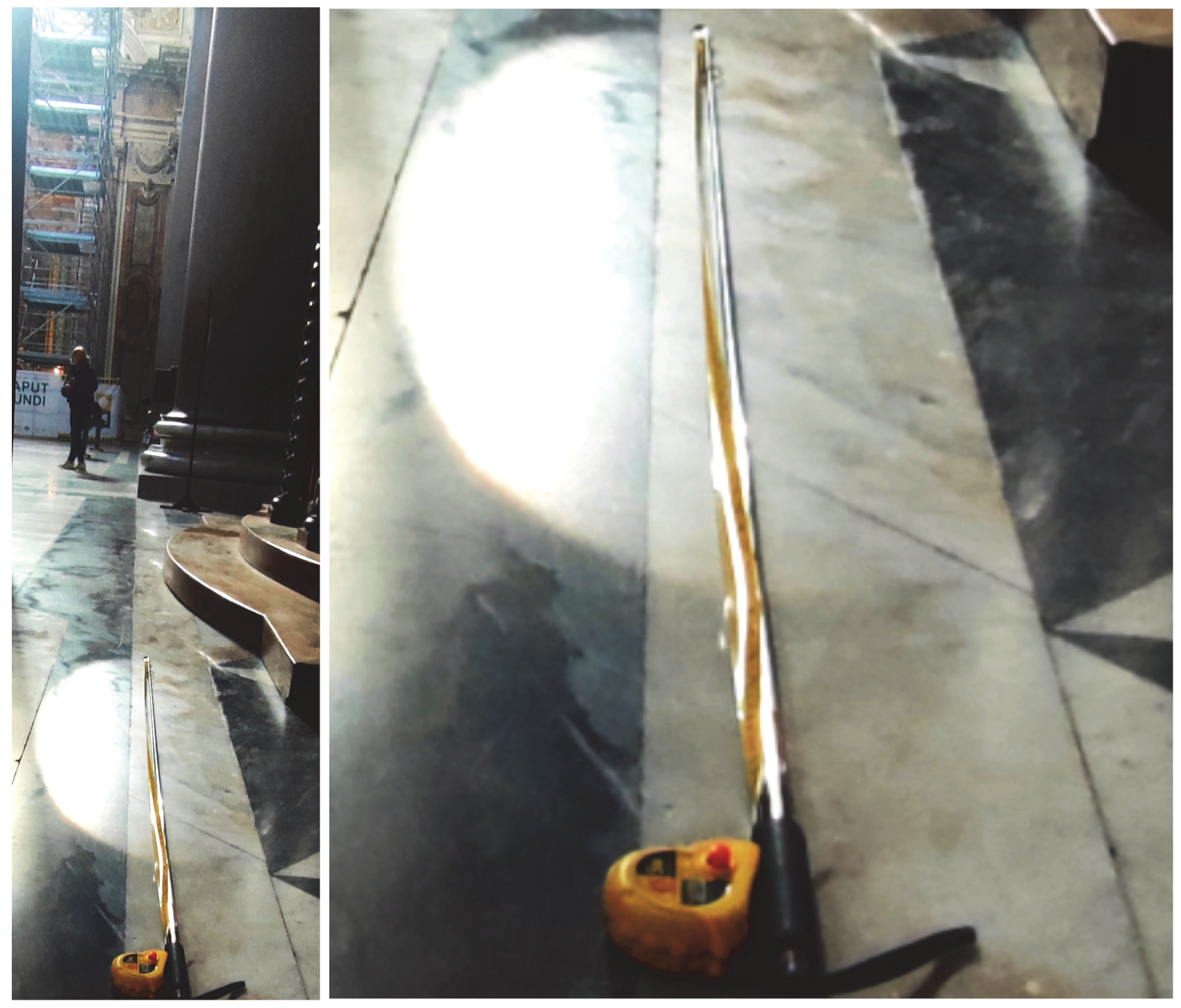
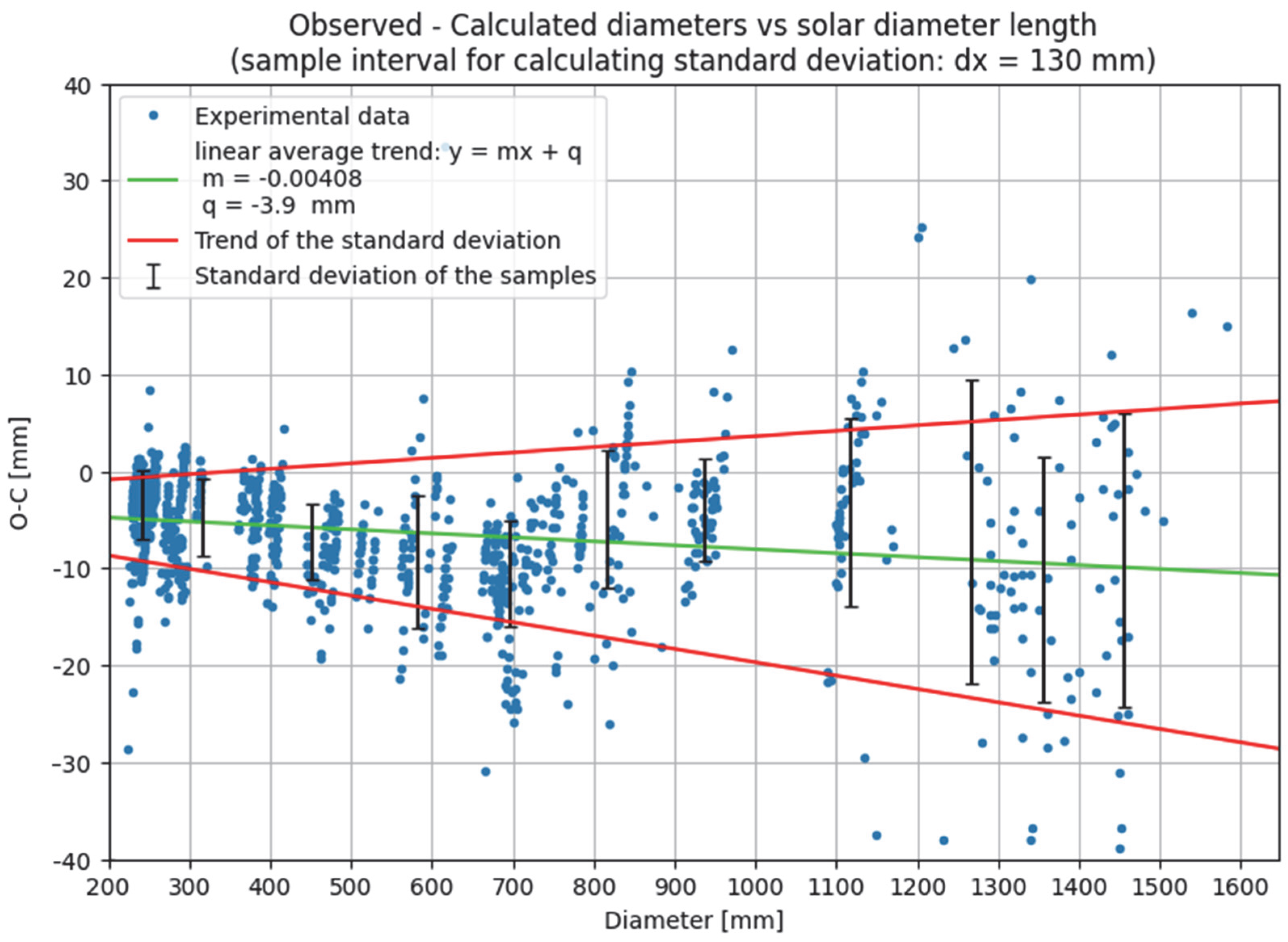
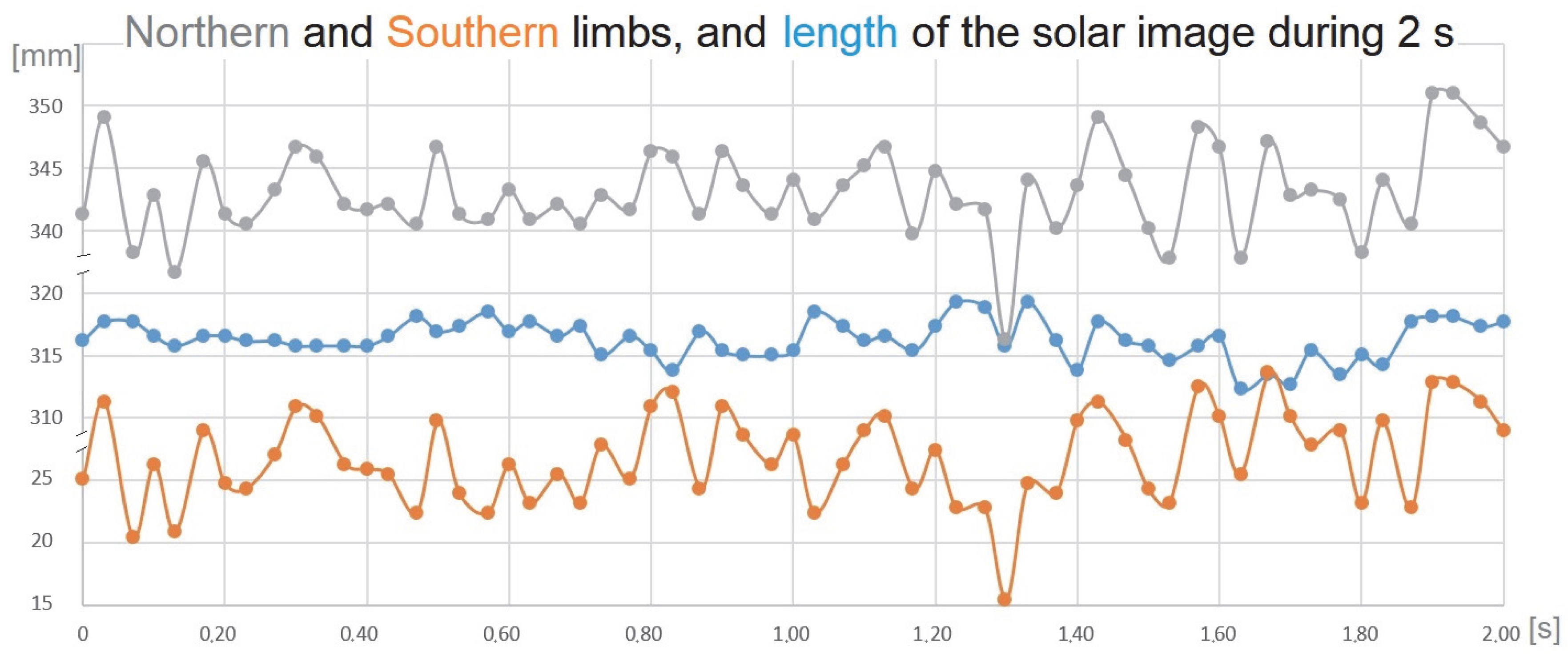



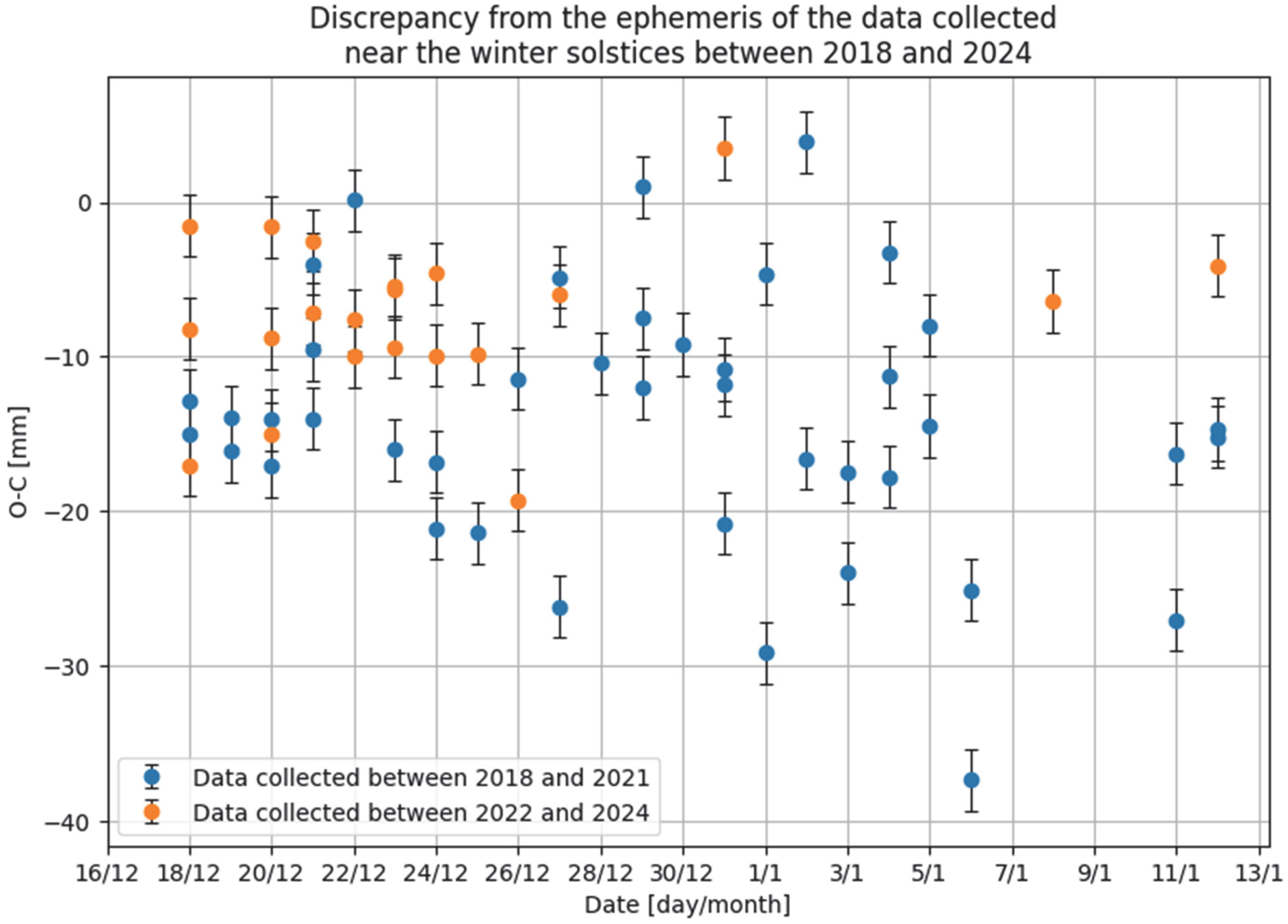
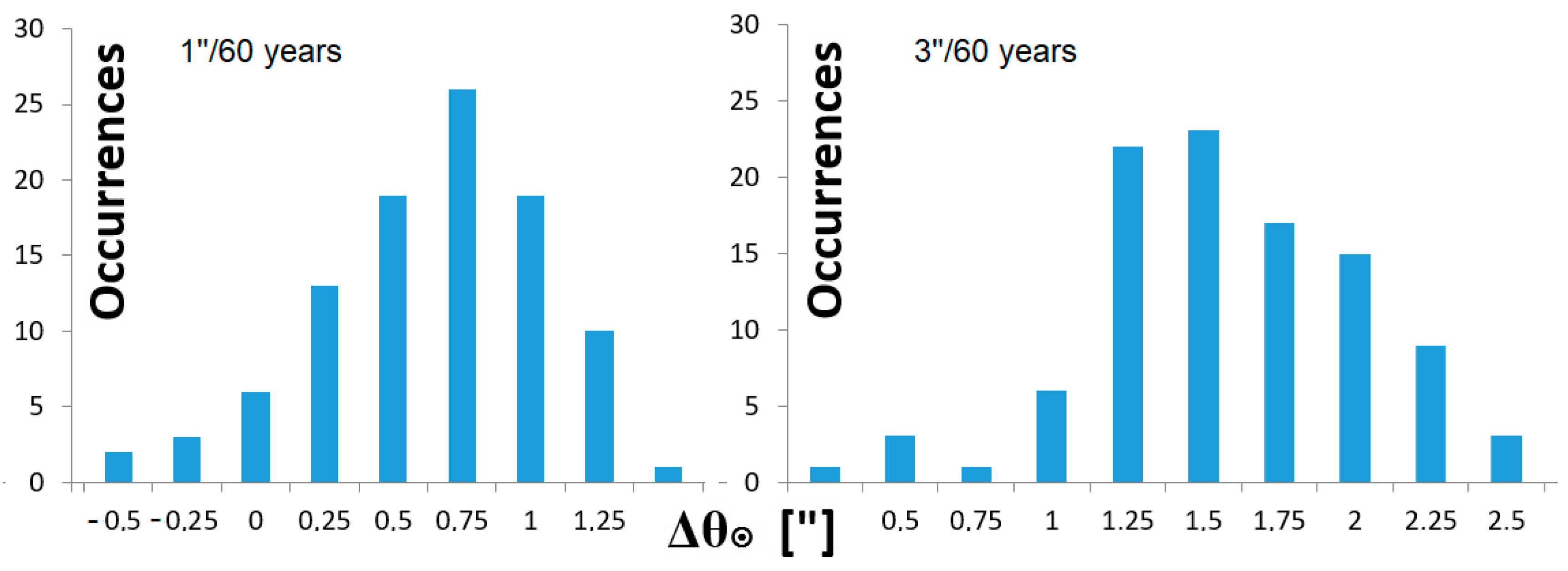
Disclaimer/Publisher’s Note: The statements, opinions and data contained in all publications are solely those of the individual author(s) and contributor(s) and not of MDPI and/or the editor(s). MDPI and/or the editor(s) disclaim responsibility for any injury to people or property resulting from any ideas, methods, instructions or products referred to in the content. |
© 2025 by the authors. Licensee MDPI, Basel, Switzerland. This article is an open access article distributed under the terms and conditions of the Creative Commons Attribution (CC BY) license (https://creativecommons.org/licenses/by/4.0/).
Share and Cite
Sigismondi, C.; Brucato, A.; Bassi, G.A. Solar Astrometry in Rome at the End of the Maunder Minimum. Universe 2025, 11, 186. https://doi.org/10.3390/universe11060186
Sigismondi C, Brucato A, Bassi GA. Solar Astrometry in Rome at the End of the Maunder Minimum. Universe. 2025; 11(6):186. https://doi.org/10.3390/universe11060186
Chicago/Turabian StyleSigismondi, Costantino, Andrea Brucato, and Giulia Andreasi Bassi. 2025. "Solar Astrometry in Rome at the End of the Maunder Minimum" Universe 11, no. 6: 186. https://doi.org/10.3390/universe11060186
APA StyleSigismondi, C., Brucato, A., & Bassi, G. A. (2025). Solar Astrometry in Rome at the End of the Maunder Minimum. Universe, 11(6), 186. https://doi.org/10.3390/universe11060186





